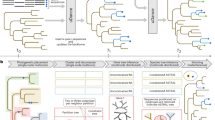Abstract
The number of protein-coding genes in an organism provides a useful first measure of its molecular complexity. Single-celled prokaryotes and eukaryotes typically have a few thousand genes; for example, Escherichia coli1 has 4,300 and Saccharomyces cerevisiae2 has 6,000. Evolution of multicellularity appears to have been accompanied by a several-fold increase in gene number, the invertebrates Caenorhabditis elegans3 and Drosophila melanogaster4 having 19,000 and 13,600 genes, respectively. Here we estimate the number of human genes by comparing a set of human expressed sequence tag (EST) contigs with human chromosome 22 and with a non-redundant set of mRNA sequences. The two comparisons give mutually consistent estimates of approximately 35,000 genes, substantially lower than most previous estimates. Evolution of the increased physiological complexity of vertebrates may therefore have depended more on the combinatorial diversification of regulatory networks or alternative splicing than on a substantial increase in gene number.
This is a preview of subscription content, access via your institution
Access options
Subscribe to this journal
Receive 12 print issues and online access
$209.00 per year
only $17.42 per issue
Buy this article
- Purchase on Springer Link
- Instant access to full article PDF
Prices may be subject to local taxes which are calculated during checkout
Similar content being viewed by others
References
Blattner, F.R. et al. The complete genome sequence of Escherichia coli K-12. Science 277, 1453–1462 (1997).
Goffeau, A. et al. Life with 6000 genes. Science 274, 563–567 (1996).
The C. elegans Sequencing Consortium. Genome sequence of the nematode C. elegans: a platform for investigating biology. Science 282, 2012–2018 (1998).
Adams, M.D. et al. The genome sequence of Drosophila melanogaster. Science 287, 2185–2195 (2000).
Dunham, I. et al. The DNA sequence of human chromosome 22. Nature 402, 489–495 (1999).
Waterston, R. et al. A survey of expressed genes in Caenorhabditis elegans. Nature Genet. 1, 114–123 (1992).
Hillier, L. et al. Generation and analysis of 280,000 human expressed sequence tags. Genome Res. 6, 807–828 (1996).
Wolfsberg, T.G. & Landsman, D. A comparison of expressed sequence tags (ESTs) to human genomic sequences. Nucleic Acids Res. 25, 1626–1632 (1997).
Ewing, B., Hillier, L., Wendl, M. & Green, P. Basecalling of automated sequencer traces using phred. I. Accuracy assessment. Genome Res. 8, 175–185 (1998).
Ewing, B. & Green, P. Basecalling of automated sequencer traces using phred. II. Error probabilities. Genome Res. 8, 186–194 (1998).
Bonaldo, M., Lennon, G. & Soares, M.B. Normalization and subtraction: two approaches to facilitate gene discovery. Genome Res. 6, 791–806 (1996).
Bernardi, G. The human genome: organization and evolutionary history. Annu. Rev. Genet. 29, 445–476 (1995).
Lewin, B. Genes IV 466–481 (Oxford University Press, Oxford, 1990).
Antequera, F. & Bird, A. Number of CpG islands and genes in human and mouse. Proc. Natl Acad. Sci. USA 90, 11995–11999 (1993).
Fields, C., Adams, M.D., White, O. & Venter, J.C. How many genes in the human genome? Nature Genet. 7, 345–346 (1994).
Green, P. et al. Ancient conserved regions in new gene sequences and the protein databases. Science 259, 1711–1716 (1993).
Mironov, A.A., Fickett, J.W. & Gelfand, M.S. Frequent alternative splicing of human genes. Genome Res. 9, 1288–1293 (1999).
Dickson, D. Gene estimate rises as US and UK discuss freedom of access. Nature 401, 311 (1999).
Larsen, F., Gundersen, G., Lopez, R. & Prydz, H. CpG islands as gene markers in the human genome. Genomics 13, 1095–1107 (1992).
Acknowledgements
We thank C. Wilson and A. Nichols for programming assistance. This work was supported by a grant from the National Human Genome Research Institute.
Author information
Authors and Affiliations
Corresponding author
Rights and permissions
About this article
Cite this article
Ewing, B., Green, P. Analysis of expressed sequence tags indicates 35,000 human genes. Nat Genet 25, 232–234 (2000). https://doi.org/10.1038/76115
Received:
Accepted:
Issue Date:
DOI: https://doi.org/10.1038/76115
This article is cited by
-
Proteome and Transcriptome Analysis of Gonads Reveals Intersex in Gigantidas haimaensis
BMC Genomics (2022)
-
A systematic review of proteomic biomarkers in oral squamous cell cancer
World Journal of Surgical Oncology (2021)
-
Global analysis of tRNA and translation factor expression reveals a dynamic landscape of translational regulation in human cancers
Communications Biology (2018)
-
How many human proteoforms are there?
Nature Chemical Biology (2018)
-
Genomic Selection, a New Era for Pork Quality Improvement
Springer Science Reviews (2015)



